From Moore to Delano to Milligan to the big and small screens…
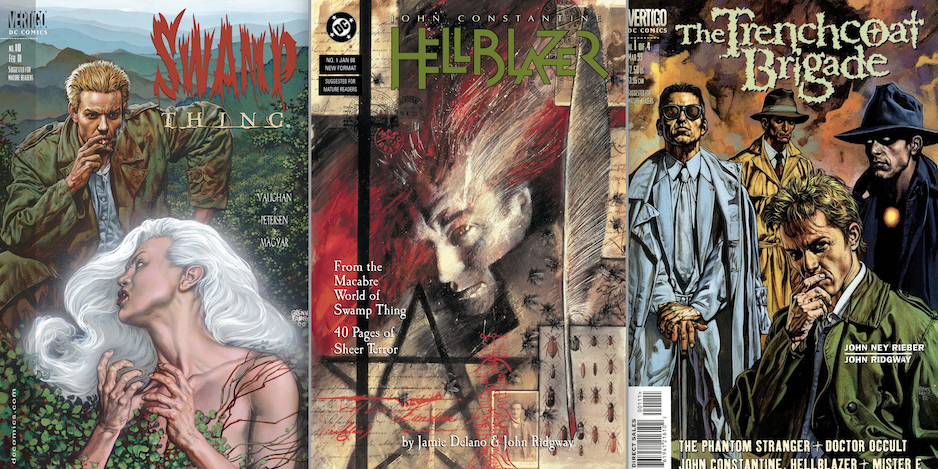
As you saw a couple weeks ago, Rich Handley’s got a new book out — Born on the Bayou: A Pre-Flashpoint Chronology of Swamp Thing and Hellblazer, with a cover by Steve Bissette.
Last time out, Rich did a piece that explored the 13 Pre-Flashpoint Eras of Swamp Thing. Now, he’s back with an INSIDE LOOK at the 13 PRE-FLASHPOINT ERAS OF HELLBLAZER.
Oh, and don’t forget, there’s still time to order a copy of Born on the Bayou for Christmas. The 558-pager is available at online retailers, including the publisher BearManor Media, for a variety of prices, depending on the format.

Here’s Rich:
—
By RICH HANDLEY
In a recent article, I demonstrated how Swamp Thing’s sprawling saga prior to DC Comics’ Flashpoint and the New 52 could be broken down into 13 distinct reading eras. That article was the result of research I’d conducted while writing Born on the Bayou: A Pre-Flashpoint Chronology of Swamp Thing and Hellblazer (BearManor Media Books, 2023). Now it’s time to deal with the second comic referenced in that book’s title, because the same is true for the world of John Constantine.
Swamp Thing, created by Len Wein and Bernie Wrightson, debuted in House of Secrets #92, then the character branched off to his own monthly title. But it wasn’t until the second Swamp Thing series, written by Martin Pasko and then Alan Moore, that the muck-monster became a major player in DC’s mythology. Moore’s Swamp Thing was groundbreaking, and not just for the profound changes it ushered in. That legendary run, illustrated by Stephen R. Bissette and John Totleben, introduced British occultist John Constantine, a trenchcoated man of mystery who, after swaggering arrogantly into Moore’s “American Gothic” storyline, became DC’s most beloved Byronic hero.
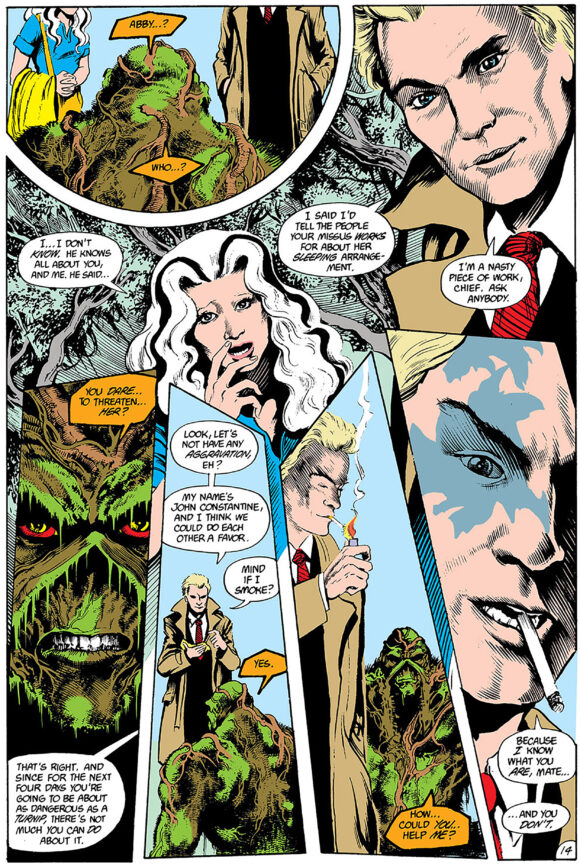
Matt Ryan’s TV portrayal has made Constantine a household name in recent years, but the mage long ago stole the show in the pages of Swamp Thing. Constantine was added to the roster in 1985’s Issue #37, following non-speaking cameos in Issue #25 and DC Sampler #3. The mage’s effect on Swamp Thing cannot be underestimated, for it was through John’s gaslighting and manipulation that Alec Holland began his journey to elemental godhood. It wasn’t long before Constantine received a spinoff, Hellblazer, which outlived its parent series by more than a hundred issues. Throughout multiple creative teams, Hellblazer’s ex-punk protagonist saved the world time and again from a range of supernatural evils, frequently getting his friends and loved ones maimed or killed in the process.
John Constantine’s journey proved just as compelling as Alec Holland’s, and readers stayed with him as the occultist aged in real time from 35 to 60 over a quarter-century of storytelling, until DC wiped the slate clean in 2011, making John young again. With Flashpoint and a company-wide reboot, DC unveiled dozens of new titles that erased its established history. Hellblazer continued in the original timeline until 2013’s issue #300, at which point pre-Flashpoint Constantine finally gave way to his younger, less nuanced double. Rather than dwell on the New 52, though, let’s examine 13 pre-Flashpoint eras of John Constantine’s life that were pure magic.
—
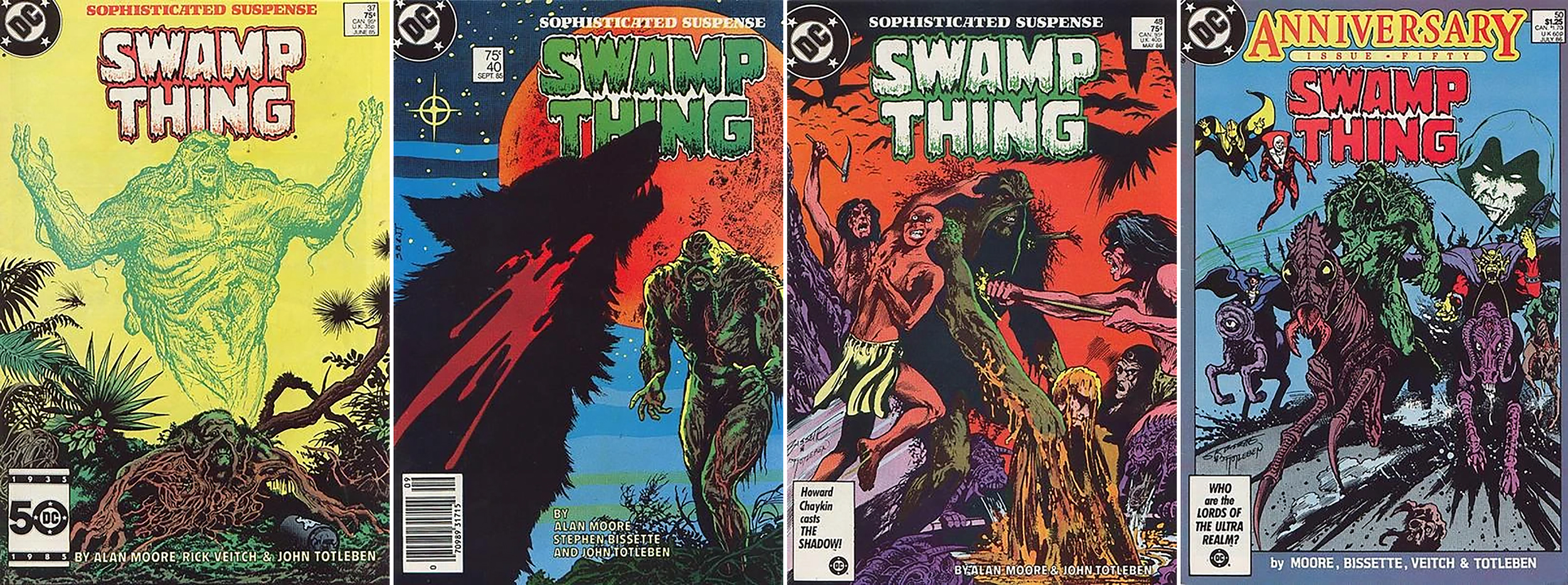
1. Alan Moore. From the moment John Constantine first arrived in the bayou, the wise-cracking Brit talked down to Swamp Thing as though to a dimwitted child. John showed Alec Holland as much respect as one might allot to rotting cabbage, and he got away with it. John knew more than he was telling, yet he portioned out information like breadcrumbs, much to the elemental’s fury. The well-dressed, ill-tempered Sting wannabe led Swamp Thing around on a mossy leash, bribing the muck-monster to do his bidding on the promise of revealing clues to his heritage and abilities. Thus was born a comics icon, and Moore proposed the 12-issue Twilight of the Superheroes as a John-centric spinoff. DC passed on that concept, though another spinoff was soon greenlit.
—
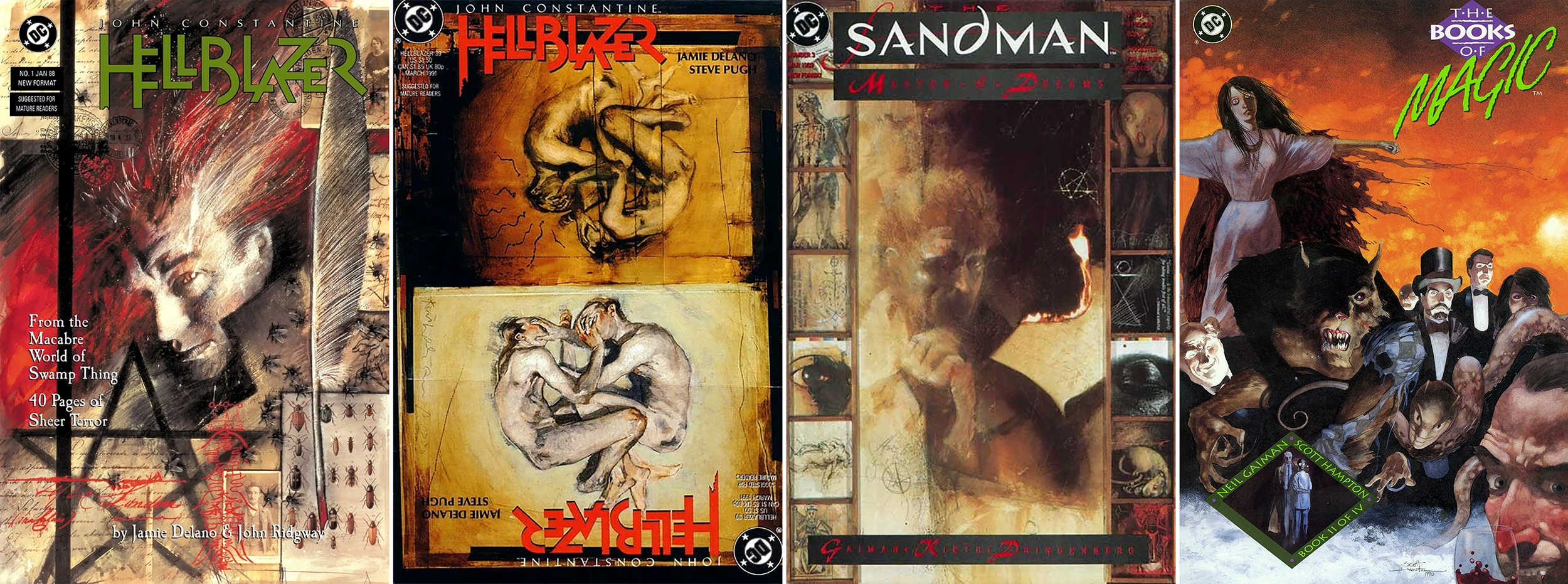
2. Jamie Delano. Created by Jamie Delano, with art by John Ridgway and others, Hellblazer featured a Constantine evolved beyond Moore’s moody mystery mage. John gained a sister (Cheryl), a niece (Gemma), and a best mate (Chas Chandler), and he exhibited greater vulnerability. He lived with hippies Zed Martin, Marj, and Mercury; used psychedelic drugs; consorted with eccentrics Ray Monde and Jerry O’Flynn; matched wits with a serial killer; met his aborted twin, the Golden Boy; and made a deal with the Hell-prince Nergal that gave him demon blood. During this period, John played a major role in the Rick Veitch and Doug Wheeler Swamp Thing runs, in which he gained an elemental daughter, Tefé Holland. He also showed up in Neil Gaiman’s The Sandman and The Books of Magic, as well as in a Swamp Thing RPG sourcebook.
—
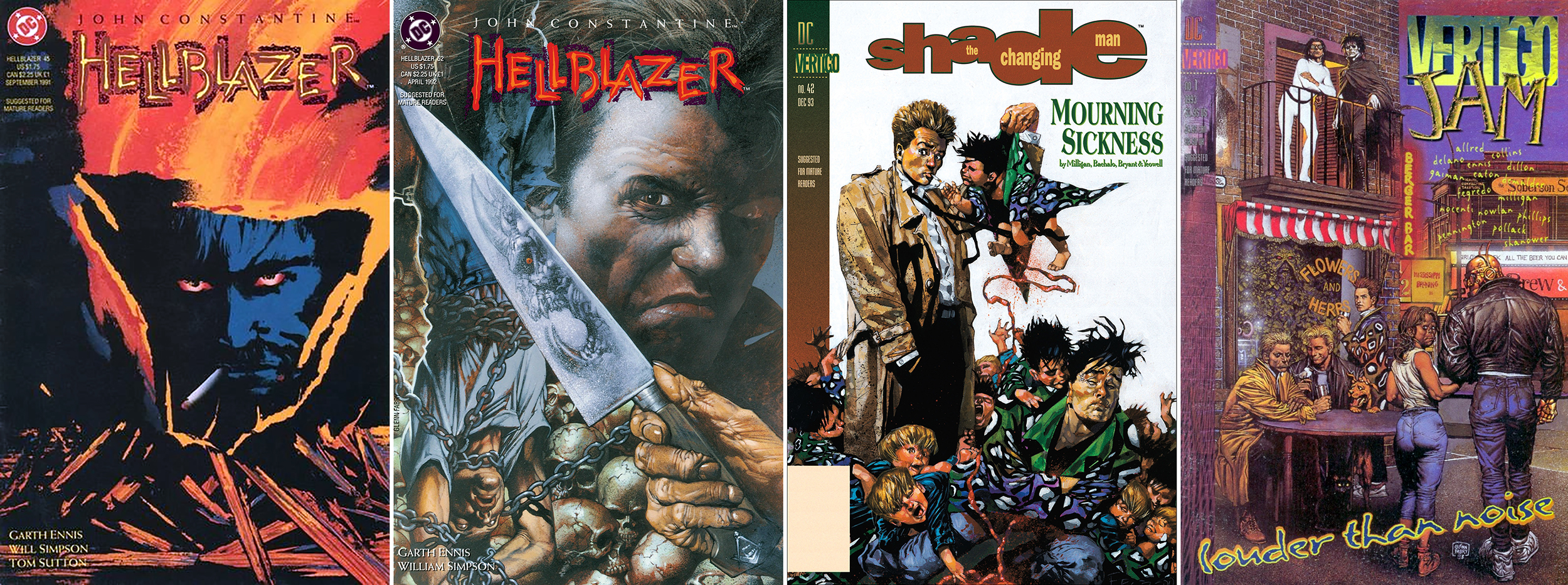
3. Garth Ennis. Illustrated by Will Simpson and Steve Dillon, Garth Ennis’ tenure took Moore’s smug bastard, melded him with Delano’s substance-abusing mystic, and added a love for pubs. The result was a more humanized—and more self-destructive—John Constantine. Ennis expanded John’s motley mates to include wine connoisseur Brendan Finn, blasphemous priest Rick “the Vic” Nilsen, and succubus frenemy Ellie, and he revealed the love of John’s life: endearing Irish lass Kit Ryan. Oh, and he gave John lung cancer and an arch-nemesis in the form of the Devil himself, the First of the Fallen. The Ennis years ran concurrent with Nancy A. Collins’ Swamp Thing arc, which explored John’s family history, and he was featured in Shade, the Changing Man, Mobfire, Death Talks About Life, Vertigo Jam: Louder Than Noise, and the Vertigo Encyclopedia promo comic.
—

4. Eddie Campbell and Paul Jenkins. Comics newcomer Paul Jenkins concluded an Australian journey initially begun by Eddie Campbell. Accompanied by artists Sean Phillips and Warren Pleece, he then resumed threads from previous runs and added many entertaining new characters to the mix, including tone-deaf royal heir Rich “the Punk” Eldridge, gentle giant Robert “Straff” Strathern, and enigmatic fairy Jack Green. Jenkins created John’s demon doppelgänger, made Robin Hood a recurring cast member, delved deeply into Arthurian lore, and incorporated Neil Gaiman’s take on Faerie. John also showed up in Grant Morrison’s and Mark Millar’s Swamp Thing saga, as well as in The Horrorist, Mythos: The Final Tour, Challengers of the Unknown, and the Hellblazer/Books of Magic crossover. Garth Ennis, meanwhile, spotlighted Kit Ryan’s family in the Heartland one-shot.
—
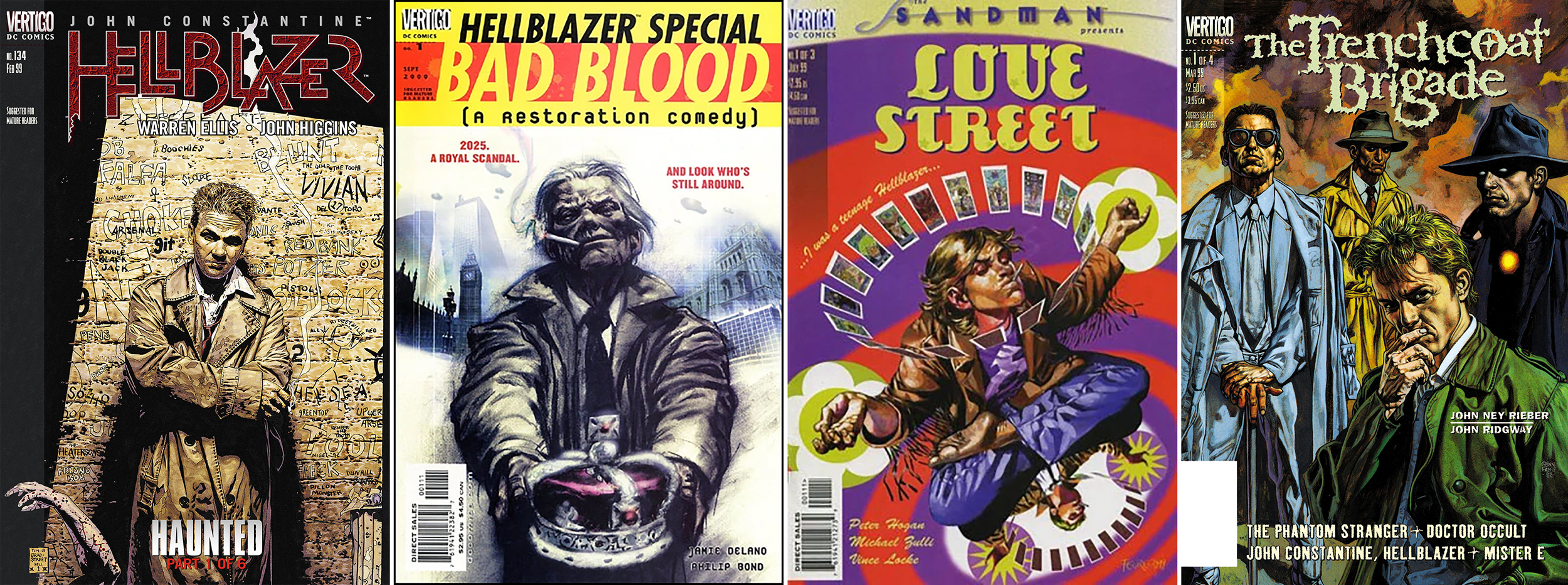
5. Warren Ellis. Artists John Higgins, Tim Bradstreet, and Marcelo Frusin drew the short-lived Warren Ellis era, following a brief return from Garth Ennis. Ellis accented his tales with a detective motif that fit the character well, and Constantine’s lifestyle moved away from fantasy, whimsy, and boozing back to horror. John hung out with magicians again, such as Clarice Sackville, Albert Case, and Ken “Map” Ondaatie, and he gained a “partner” of sorts in unscrupulous Detective Watford. Sadly, Ellis quit after only 10 issues when DC refused to publish his guns-in-school story “Shoot,” repeating a mistake it had made with Rick Veitch’s canceled Jesus tale (though DC later released “Shoot” as Vertigo Resurrected). Additionally, John starred in Delano’s Bad Blood, Peter Hogan’s Love Street and unpublished Marquee Moon, John Ney Rieber’s The Trenchcoat Brigade, and the three Winter’s Edge anthologies.
—
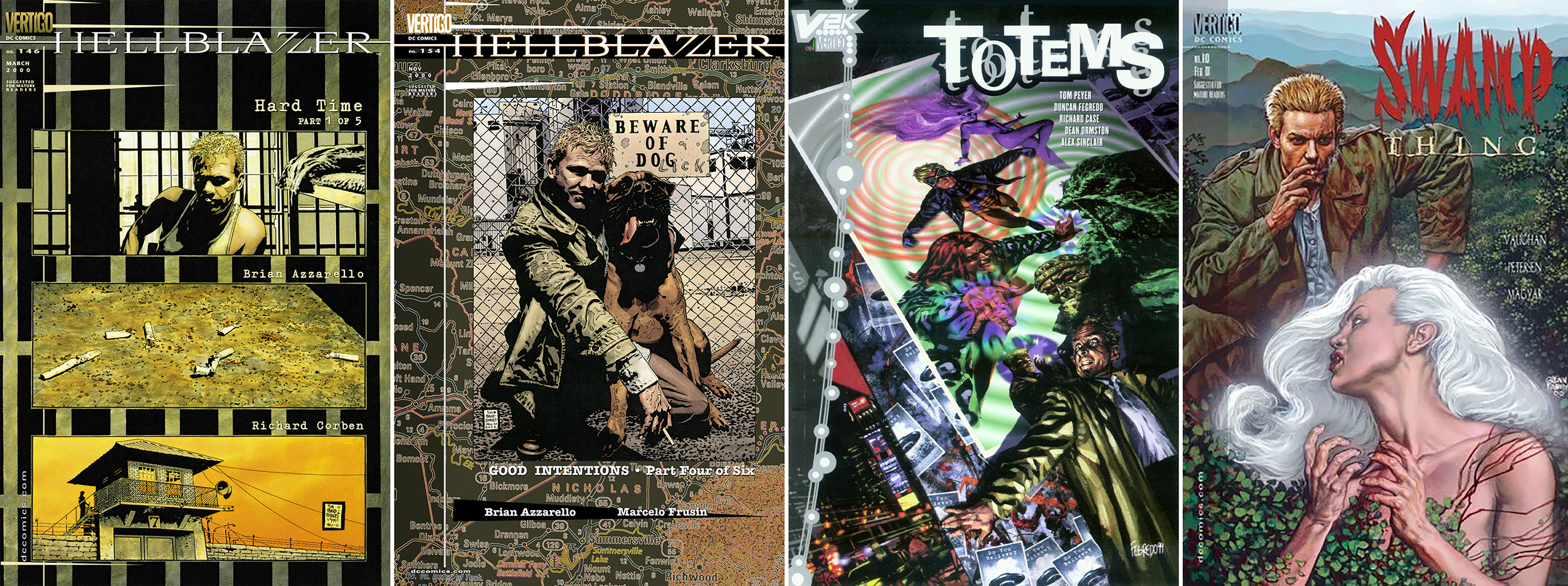
6. Darko Macan and Brian Azzarello. After a fill-in two-parter from Darko Macan, Brian Azzarello sent John to prison for murder and put him on a trek across the redneck underbelly of the U.S. Midwest. John hung out with neo-Nazis and other criminals, was recorded by bestiality pornographers, talked a stranger into killing himself, tricked a former friend into setting himself on fire, and reveled in unnerving strangers, grinning all the while like a Joker-like sociopath. The writer introduced John’s evil ex-boyfriend, a psychotic Bruce Wayne analogue named S.W. Manor (stately Wayne Manor from the Batman TV show… get it? Nudge nudge?), who was a dud of a Big Bad, if truth be told. During this period, John also appeared in Brian K. Vaughan’s Swamp Thing, V2K: Totems, The Names of Magic, a Vertigo Secret Files special, and the second of two 9-11 graphic novels.
—
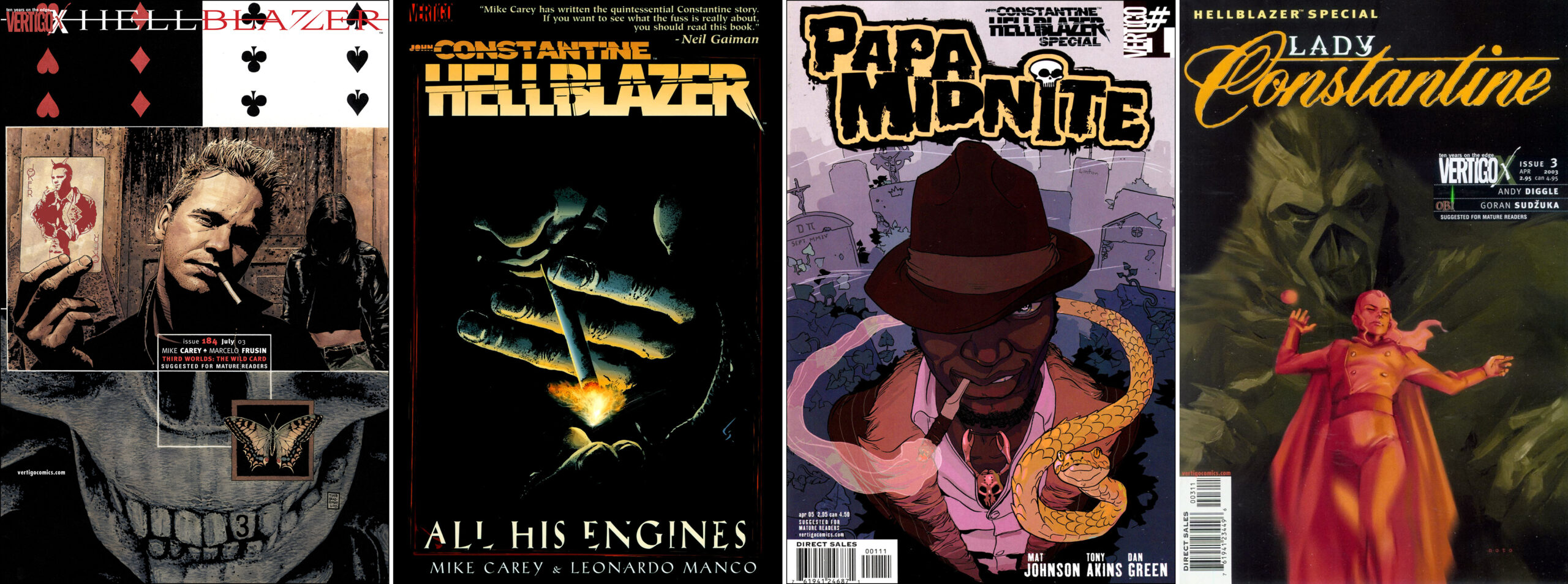
7. Mike Carey. Lucifer’s Mike Carey picked up where Ellis left off, bringing back that writer’s cast for one of Hellblazer’s most celebrated—and darkest—incarnations. Cheryl was slain by her Bible-toting husband and consigned to Hell; a Nergal-possessed Chas beat his wife Renee to a pulp; and gangsters brainwashed John’s niece Gemma, causing her to sever ties with her uncle. The mastermind behind all this suffering? The demoness Rosacarnis, daughter of Nergal, who tricked John into living 40 hellish years in a day and fathering three demonspawn who slaughtered his friends. John also starred in Carey’s extraordinary graphic novel All His Engines, the Andy Diggle and Josh Dysart Swamp Thing arcs, and Zatanna: Everyday Magic. In addition, DC published a pair of Hellblazer miniseries titled Papa Midnite and Lady Constantine.
—
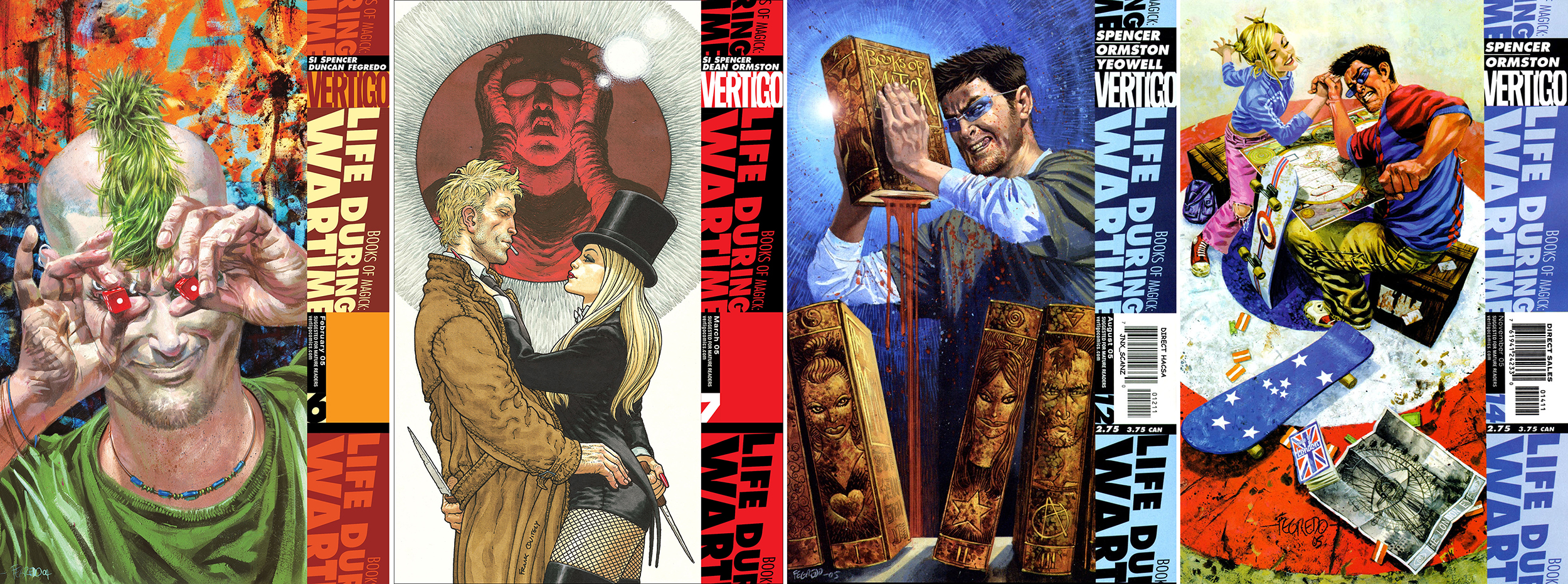
8. Si Spencer. Concurrent with Carey’s Hellblazer, Constantine starred in a separate, unrelated series titled Books of Magick: Life During Wartime, written by Si Spencer, with art by Dean Ormston, Steve Yeowell, and Duncan Fegredo, and script consultation by Neil Gaiman. The comic was set on two fictional worlds connected via an alternate iteration of DC’s Harry Potter predecessor, Timothy Hunter. Humans and faeries shared a war-torn other-Earth, with both sides worshipping Hunter as a god, and among Tim’s closest allies were Constantine and fellow magician Zatanna Zatara. One world contained a female John analogue named Jackie Constantine, whose best friend and lover was Charlotte, a female Chas. The gender-swapped pair were among the comic’s highlights, and DC should consider bringing them back into the fold.
—
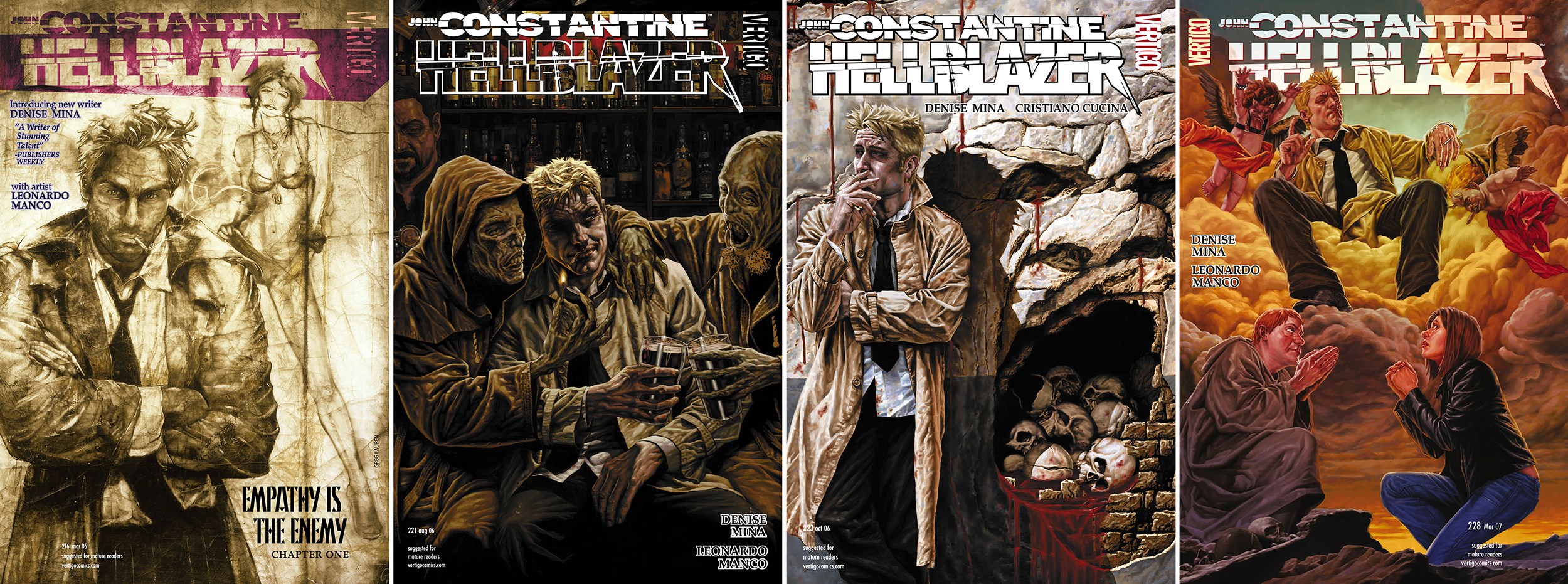
9. Denise Mina. As Carey’s saga concluded, Constantine turned his back on magic—which didn’t stop John from falling right back into his same old patterns when Denise Mina signed aboard. Mina’s run revealed a realm for dead souls beyond Heaven and Hell, while subjecting the planet to an empathy epidemic unleashed by a well-meaning religious order that sought to teach mankind compassion but instead unwittingly caused worldwide suicides. Mina wasn’t working with the same John whose adventures everyone from Moore to Jenkins had chronicled. This was the older, more cynical Constantine who’d also experienced the middle-aged exploits of Ellis, Azzarello, and Carey. He’d grown more aloof, more jaded, and was less willing to put himself out there. As such, the so-called Third Place appealed to John, who longed for a numb respite from his lifelong mental grief.
—
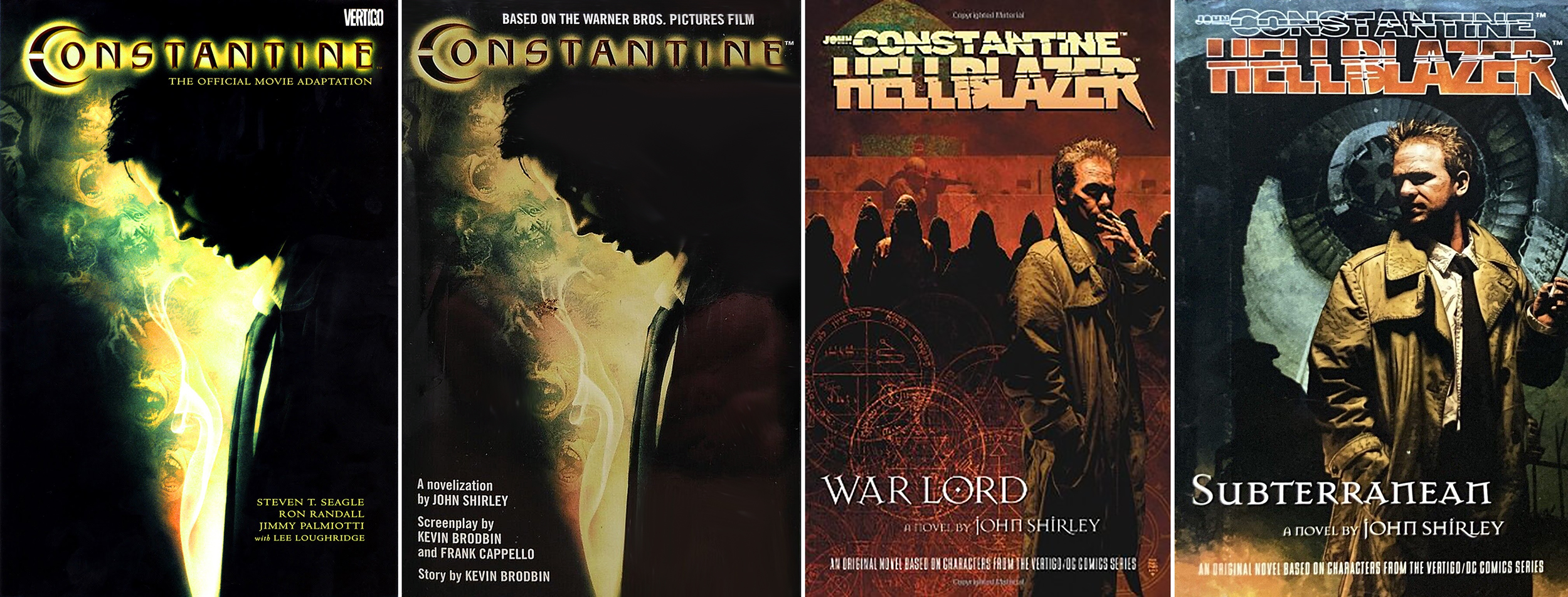
10. John Shirley. A trio of novels penned by John Shirley ran concomitant with the Carey and Mina arcs. The first book adapted the movie Constantine, also adapted in comic form. Shirley was then invited to write a pair of original novels, War Lord and Subterranean, which pitted John against a demonic cult and a megalomaniacal underground alchemist. The novelist’s unorthodox supporting cast included a dead surfer, a dead terrorist, undead Roman soldiers, the brain of Nazi physician Josef Mengele, and a ghostly army called the Peace Corpses, as well as Mercury from Delano’s run, and a slew of trolls, giants, water spirits, faeries, harpies, and other magical creatures. Intriguingly, the books acknowledged the Keanu Reeves movie as occurring in an alternate reality within the comics continuity, reconciling the differences between the film and its source material.
—
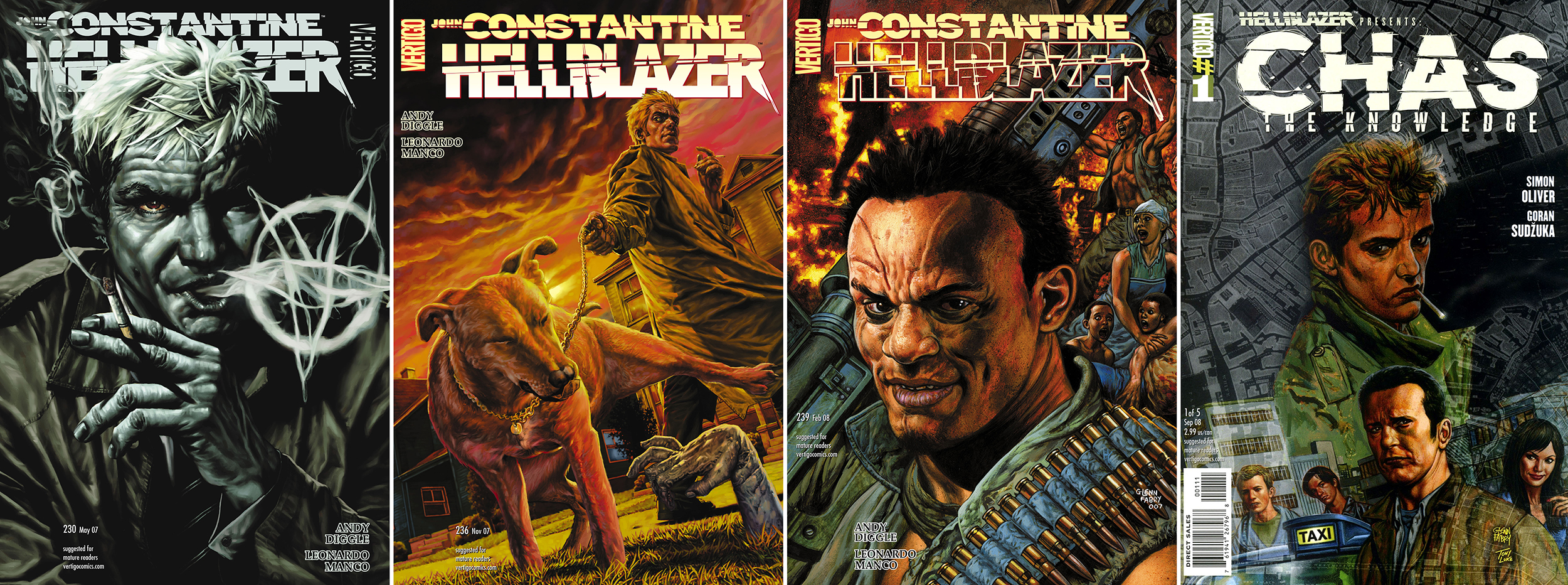
11. Andy Diggle. As he’d done with his Swamp Thing arc, Andy Diggle heavily mined his predecessors’ concepts while writing Hellblazer. He brought Constantine back to the Ravenscar asylum where he’d been mistreated, this time as sharply dressed as in Moore’s day, for John returned not as a patient but as someone looking to buy the place—which was now a hotel and casino. What’s more, this era offered closure to the Golden Boy, John’s aborted magical twin from the Delano days. In the interim, Diggle introduced new villain Mako, a Sudanese war mage who devoured other magicians’ powers. Many magic users fell as Mako gained abilities, including most of Clarice Sackville’s colleagues, and John nearly succumbed as well. During this run, DC also published Chas: The Knowledge, a Chas Chandler miniseries by Simon Oliver, Goran Sudžuka, and Glenn Fabry.
—
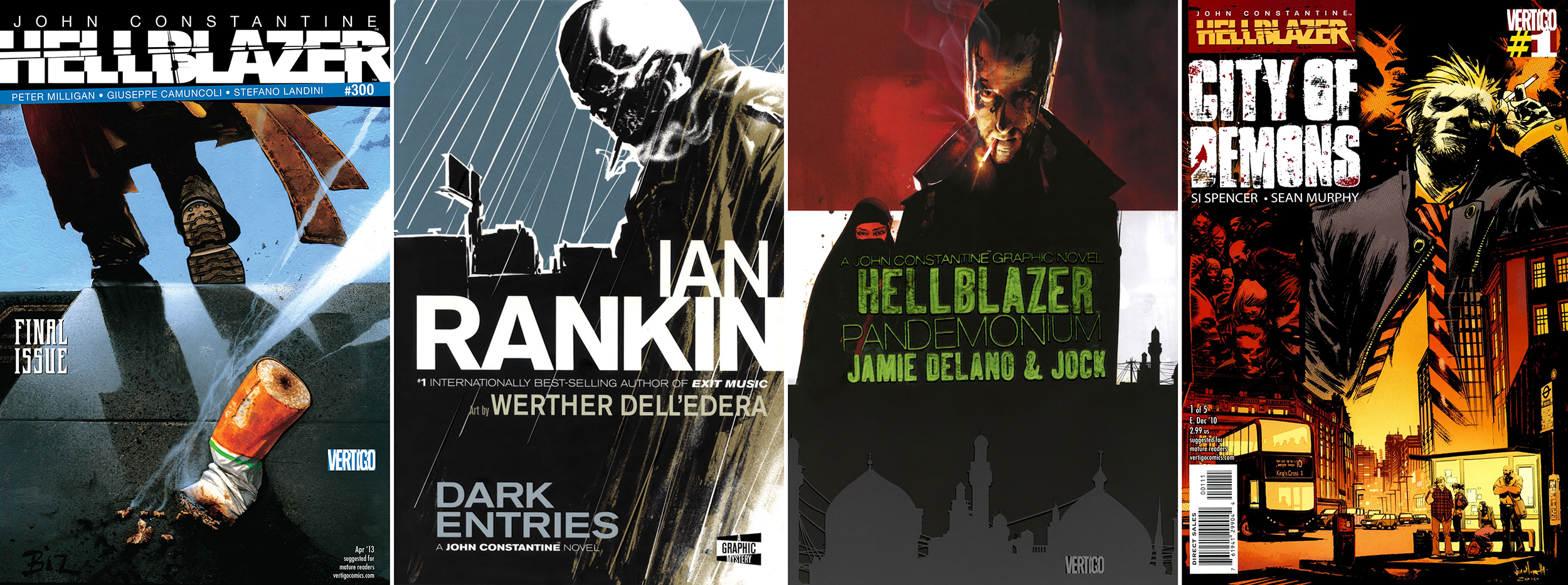
12. Peter Milligan. Constantine had lost much during prior storylines, so Peter Milligan instead gave him happiness, by having John marry 23-year-old alchemist Epiphany “Piffy” Greaves. John was pushing 60 and was older than her gangster father, yet there was chemistry there, and it wasn’t just the alchemy. Piffy was irreverent, sexually insatiable, bisexual, and a punk fan—in short, a younger, stabler, female John. But after his demon double raped Gemma, John grew tired of endangering those he loved. He thus abandoned Piffy and Chas, and Hellblazer reached its somber end with the geriatric mage all alone. During the Milligan years, DC published the Hellblazer graphic novels Dark Entries (by Ian Rankin) and Pandemonium (Jamie Delano), as well as Si Spencer’s Hellblazer: City of Demons miniseries, while John guest-starred in a pair of House of Mystery annuals.
—
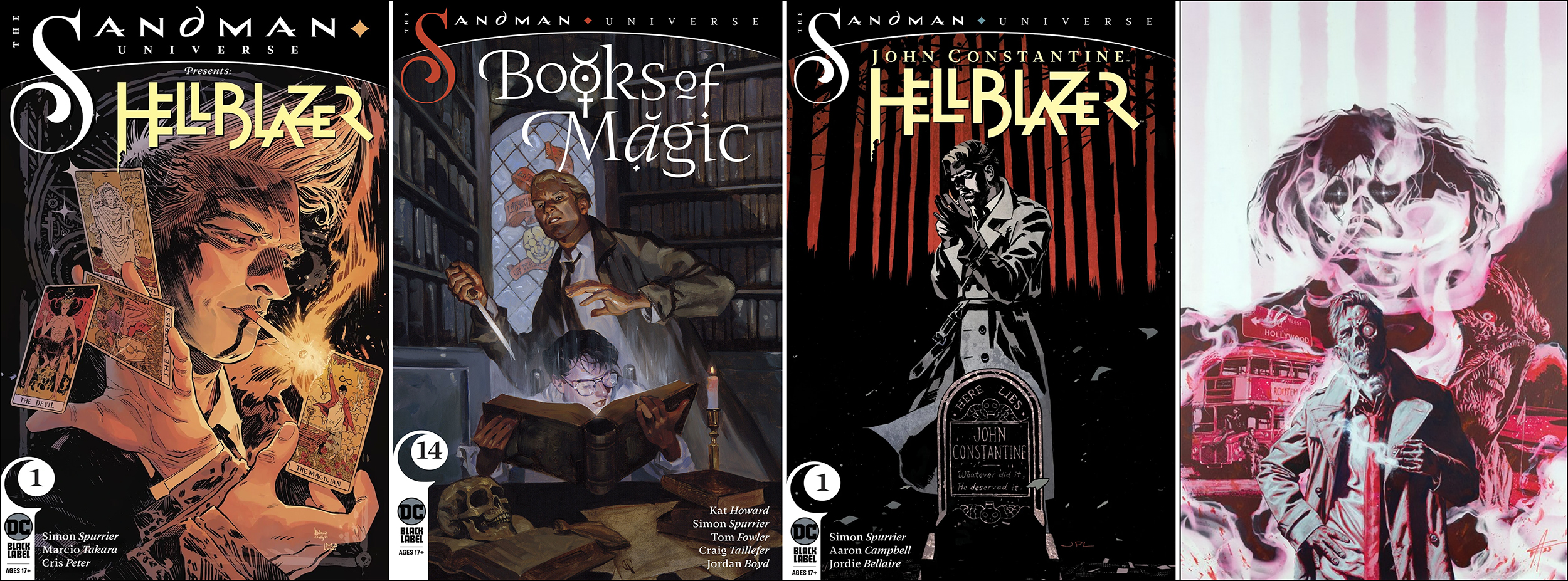
13. Si Spurrier. Hellblazer #300 wasn’t the end of Constantine, but it was the end of John as we knew him. During Brightest Day and Flashpoint, the occultist was de-aged along with countless other characters as part of DC’s New 52 reboot. This new, younger John was a very different man, but writer Si Spurrier and artists Tom Fowler, Craig Taillefer, Marcio Takara, and Aaron Campbell revisited the prior continuity. A soulless tulpa, modeled after Milligan’s lonely old John from Issue #300, made a deal to acquire the soul of the dying alternate-reality Constantine from the magic war in Gaiman’s original Books of Magic. The tulpa created havoc for his younger self in the revived Hellblazer and Books of Magic lines under Gaiman’s The Sandman Universe banner, and it was glorious. A continuation, Hellblazer: Dead in America, will debut in 2024.
—
The strength of any series and character relies on their ability to adapt with the passage of time. Despite cancelations and revamps, Hellblazer and John Constantine endure, with new stories involving new challenges being told in a new timeline tailored to a new generation. The man of mystery continues to blaze a path through Hell, often leaving as much death and destruction in his wake as he manages to avert. Much has changed post-Flashpoint, but thanks to Spurrier and his art team, the spirit of the original Hellblazer remains alive and well.
—
MORE
— BORN ON THE BAYOU: An INSIDE LOOK at the 13 Pre-FLASHPOINT Eras of SWAMP THING. Click here.
— The 13 Greatest HORROR COMICS Ever. Click here.
—
RICH HANDLEY (richhandley.com) is an author and editor of numerous Star Trek, Star Wars, and Planet of the Apes books and comics, as well as projects involving Watchmen, Back to the Future, Stargate, Dark Shadows, Batman, Red Dwarf, and other franchises. His books include Born on the Bayou: A Pre-Flashpoint Chronology of Swamp Thing and Hellblazer (BearManor Media), From Bayou to Abyss: Examining John Constantine, Hellblazer (Sequart), and John Constantine, Hellblazer: 30th Anniversary Celebration (DC Comics). Rich edited Eaglemoss’s Star Trek Graphic Novel Collection and currently writes articles and short fiction for Titan Books’ Star Trek Explorer magazine.
